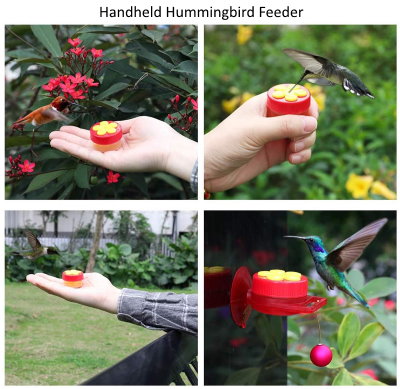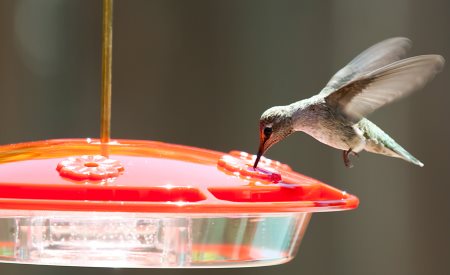
Best Hummingbird Feeders (2024)
Below we have listed the best hummingbird feeders for 2024 and also tips for where to hang and how to clean your hummingbird feeder.
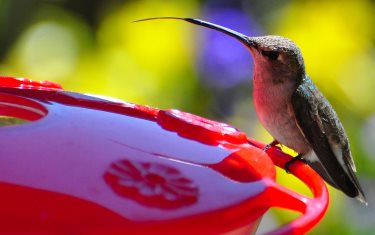
Hummingbirds will learn to use most any feeder, so whether or not a feeder will attract hummingbirds is not part of our criteria.
We have tips on how to attract hummingbirds to your feeders.
The criteria is based on these features:
- Easy to fill - don't use red dye nectar!
- Easy to clean - more on how to properly clean your feeder
- Durability
- Capacity
- Extra features like perches, built-in ant moat (how to keep ants out of your feeder), feeding ports that divert rain, hanging and mounting options, etc.
Best Hummingbird Feeder Overall
We have tried lots of different types of feeders and we have come to the conclusion that the best hummingbird feeder overall is the:
The Hummzinger is a type of saucer feeder, which is drip-free unlike vacuum bottle style feeders.
Read more about choosing a hummingbird feeder and the different styles.
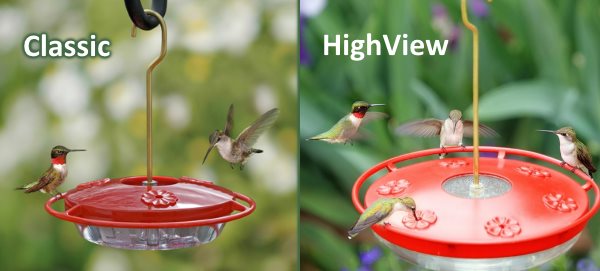
The HummZinger comes in a variety of models:
- Classic - Original 12 oz design with perch slightly below feeding ports
- HighView - Elevated perch above feeding ports for better view of hummingbirds
- HummZinger Fancy - 8 oz medium feeder with 3 feeding ports
- HummBlossoms - Mini 4oz feeder with 3 feeding ports and high view perch
Classic vs High View HummZinger Feeders
The difference between the HummZinger Classic and HighView is the perch position.
In the High View, the perch is elevated above the feeding ports.
This isn't necessarily a benefit for the hummingbirds, but more so for the birdwatcher as it offers unobstructed views of the entire bird.
I've watched hummingbirds using perches on both the Classic and HighView and it doesn't seem to make much difference; some hover and sip, and some perch and sit on both models.
So if you prefer a better view of the hummingbirds, get the HighView Feeder.
Both the Classic and High View come in three sizes: 8 oz, 12 oz, and 16 oz.
Features and Benefits of the HummZinger Hummingbird Feeder
- Leak and drip proof - the basin style feeder (vs the tube style gravity fed feeder) where the nectar cannot drip and leak, is the best advantage of this feeder. Leaky feeders attract bees, wasps, and ants more so than basin feeders.
- Ant-moat - I love the built in ant moat. You simply fill it up with water and ants or other insects are blocked from reaching the feeding ports. They designed it with overflow holes so you can't overfill it or rain water won't overflow into the main feeding basin and dilute the nectar.
- The polycarbonate construction is very durable and long-lasting. We've had our for years and it shows no signs of cracks or weak points.
- Dishwasher safe - for easy cleaning, you can throw it in the top rack of your dishwasher. But, we usually just wash it by hand with a mild vinegar solution.
- Nectar level indicator
- Raised flower design around feeding ports divert rain
- Lifetime guarantee - Aspects HummZinger hummingbird feeders come with a lifetime guarantee against defects or damage.
- You can hang or post-mount your feeder. There is a 5/8" hole on the underside of the feeder where you can insert a wooden dowel or copper tubing for mounting.
Other Aspects Hummingbird Feeders
HummBlossoms and Fancy
The HummBlossoms are small capacity feeders (4 oz) with the idea that you can place more of them all around your yard without hummingbirds becoming so territorial over one particular feeder.
The HummZinger Fancy is a little more decorative, but still as functional as the classic, so that's up to you if you want a little more flare in your feeder design.
The Fancy comes in 8 oz and 12 oz sizes.
Window Hummingbird Feeders
Aspects also makes two types of window feeders:
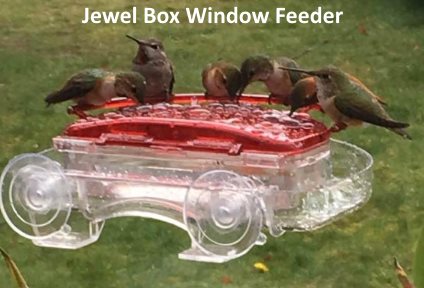
The Jewel Box feeder has an 8 oz. feeding capacity with 3 feeding ports. The Gem has a 4 oz capacity.
I like how easy it is to fill. You can slip out the nectar container without having to remove the feeder from the window. And then the top of the container hinges up for easy filling.
Hummzinger Jewel Box Window Feeder
Best Tube or Vacuum Glass Bottle Hummingbird Feeder
We like glass reservoirs over plastic because they don't deteriorate in the sun like plastic, so they're longer lasting. Also, they don't retain and promote mold growth and are easier to get completely clean.
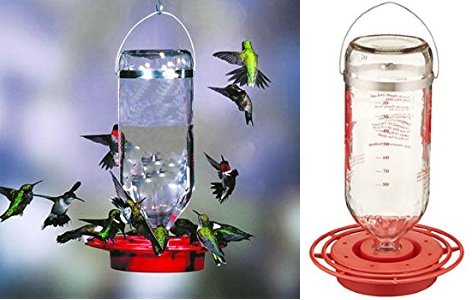
This 32 ounce Best Hummingbird Feeder by Bird Choice (also comes in a 8 oz size) is a great large capacity feeder with a glass bottle reservoir and 8 nectar feeding ports.
The base comes apart for easy cleaning.
It's a simple design, but simple is good. Easy to fill. Easy to clean.
More Glass Hummingbird Feeders
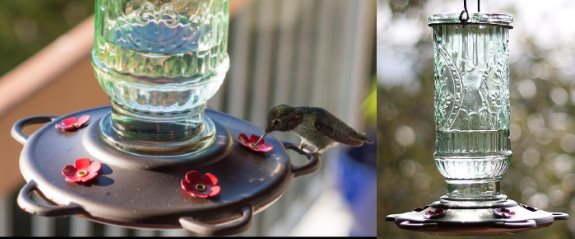
We have a page dedicated to glass hummingbird feeders which include hand-blown glass feeders, vintage antique glass hummingbird feeders, as well as other clear glass tube style feeders.
Handheld Hummingbird Feeders
What size hummingbird feeder should I get?
Unless you have a lot of hummingbirds, don't get the biggest capacity unless you can commit to changing out the nectar and cleaning the feeder when it's necessary: at least every 3 days in hot weather and 6-7 days in cool weather.
I know some people will fill up a feeder with 16 ounces and then let it sit in the warm weather for a week or more because they don't want to throw away the nectar or because they're lazy.
If you do want the larger capacity size feeder, and find that the hummingbirds aren't drinking it up as quickly, then you could always fill it up partially if you don't want to waste nectar.
Yes, we are putting out feeders for our own enjoyment, but also to feed hummingbirds.
If we put out nectar that is growing mold and fermenting because we're too lazy to change out the nectar and clean the feeder, then we're better off not feeding them at all.
Hummingbird Feeders - Nectar, Attracting, Cleaning, When to Put Up/Take Down and More Tips
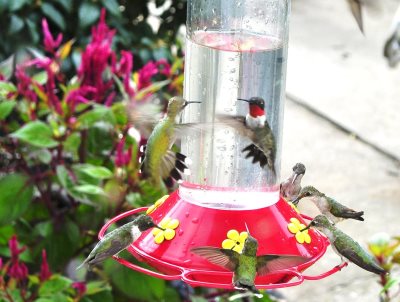
Hummingbird feeders provide 2 functions:
- They provide hummingbirds with an alternate source of food/energy.
- They provide humans with an alternate source of entertainment! :-)
Choosing a Hummingbird Feeder
There are 2 basic designs of hummingbird feeders: vacuum and saucer.
Vacuum Hummingbird Feeders
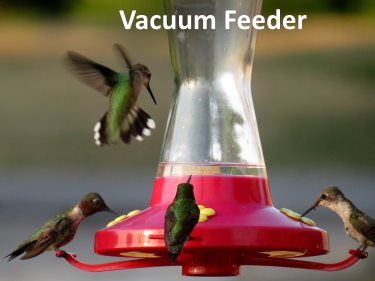
A vacuum feeder has a container that drains the nectar into a reservoir with feeding ports.
A vacuum is created at the top of the container when it is turned upside-down, keeping the sugar solution from flowing out of the feeder ports.
All vacuum feeders can drip.
This most often occurs when the solutions is heated during the day. The increasing temperature causes the solution to heat & expand, forcing some nectar out the feeding ports, where ants, bees, & wasps can get to it.
This can be avoided somewhat if the feeder is placed in a cooler, shady location.
They also can drip if they swing and are tilted on windy days.
Saucer Hummingbird Feeders
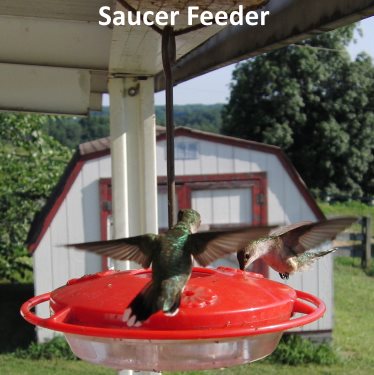
As the name suggests, these hummingbird feeders are shaped like a saucer, with feeder ports located on the cover of the reservoir.
These feeders are essentially drip-free unless tipped because the horizontal reservoir is below the feeding ports instead of above as in vacuum feeders.
A saucer-style feeder has a low profile which is an advantage if your feeder will be exposed to wind often.
So which style should I choose?
As far as hummingbirds go, they'll feed from either design. What may be
more important are other factors such as:
- Easy cleaning
- Durability
- Transparency
- Pest deterrence (bees, wasps, ants, etc.)
Get a Feeder that is Easy to Clean
When you are selecting your feeder make sure that it will be easy to clean, refill, and has a clear reservoir for you to easily see how full or empty it is.
You don't want a feeder that has a lot of intricacies or hard to reach places that will be difficult to clean.
Nor one that is difficult to open & refill without leaking sticky, sugar-water all over you & your kitchen.
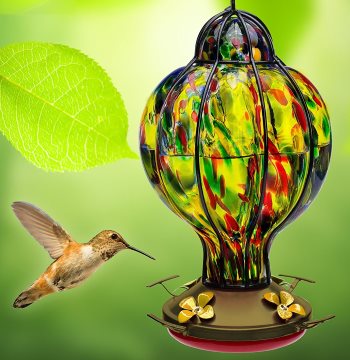
Those decorative ones sure are pretty, but may be too hard to clean.
And if they don't have clear, transparent reservoirs you'll have a difficult time seeing how full it is, or if the solution is going bad (getting cloudy).
So try out feeders in the store - take them apart and pretend they're full of sticky, sugar-water & see how easily they are to open & clean.
If it's too difficult to clean, it won't get done & the hummingbirds will be the ones who suffer the consequences.
Don't put up a feeder if you don't have time to clean it.
Bee guards are also a nice feature to look for when choosing (see "pests").
Perches or no perches?
There are no perches on flowers for hummingbirds to use when feeding (hence hovering).
But wouldn't you rather sit than stand when eating?
Perches give hummingbirds a break and give you a closer look. Rather than seeing their wings as a blur, you will see more details as they sit & sip.
Perches may encourage other birds to visit as well (see "other birds").
Size
As far as size goes, choose a smaller one at first.
There is no need to get a huge one, because your feeder only needs to hold no more than a few days of nectar (see "cleaning").
If your visitation increases, and your reservoir needs daily refills, then you may want to go with a bigger feeder or just put up several small ones.
Our Favorite Hummingbird Feeder
--> View The HummZinger Hummingbird Feeder
HummZinger Feeders come in several different sizes and styles - 8 oz mini, 12 oz, and 16 oz as well as a "HighView" model where the perches are raised.
Below are some of the popular HummZinger models:
Making Your Own Nectar
To learn more about making your own hummingbird nectar for your feeders go to which discuses in detail about natural nectar composition, using lower or higher concentration of sugar, not using red dyes go to our our hummingbird food recipe page.
Don't Use Anything But Plain White Granulated Table Sugar To Make Your Hummingbird Food!
Do not use any of these sweeteners when making your hummingbird food:
- Honey
- Raw Sugar
- Brown Sugar
- Agave Nectar
- Corn Syrup
- Brown Rice Syrup
- Fruit Juice
- Etc., etc..
Why not?
Honey, for example, is primarily composed of fructose and glucose as opposed to sucrose.
Hummingbirds can't digest it as efficiently. Fermentation & mold growth also occurs faster in honey solutions than those made from granulated sugar. This mold (fungus) can give the hummingbirds a fatal tongue infection.
Read more about why you should only use plain, white, granulated table sugar on our hummingbird nectar recipe page.
And in case you were thinking, because we have been asked...
DO NOT USE artificial sweeteners either which provide no calories (no energy).
Just Say No to Store-bought Nectar
Pre-made nectars you find in stores offer no advantage over homemade.
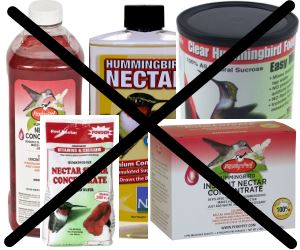
The liquid ones will have preservatives & artificial colors (don't use red dye in your nectar) that hummingbirds don't need & may even be harmful.
Instead of using artificial dyes in your solution, wrap the feeder with red ribbons or tape to add color.
And why bother with the dry mixes?
They're just sugar (which may have preservatives & colors added as well) that you have to add water to anyway - so just use your own sugar at home and save some $$.
And those mixtures that are fortified with vitamins, minerals, etc. are unnecessary as well.
Hummingbirds supplement their diet with insects & spiders and, if necessary, with natural flowers if they aren't getting what they need from your feeder.
We discussed this further in the article: Why You Should Stop Buying Hummingbird Food.
To make your hummingbird nectar solution:
When creating a sugar solution for your feeder, the best ratio is 1 part white, granulated sugar to 4 parts water, since this closely approximates the concentrations found in the nectar of wildflowers they prefer.
- Using a 1:4 ratio, stir 1/4 cup white granulated sugar into 1 cup of boiling water.
- Stir until the sugar dissolves.
- Cool & serve.
- Any leftover nectar can be stored in the refrigerator for 2 weeks.
As mentioned on our hummingbird food recipe page, higher concentrations (up to 1:1) can be made, especially during cold migration periods.
Why Is My Hummingbird Feeder Leaking?
Besides the obvious reason that you may not have properly attached the feeder to the base after filling your feeder, there is another common cause.
Usually a hummingbird feeder will be leaking if you have a vacuum style feeder.
A vacuum feeder is one where there is a bottle that sits upside down on top of the feeding ports.
This style of feeder is more likely to leak, especially when the nectar becomes heated by the sun.
If you have this kind of feeder, try to hang it in a shaded location or create shade.
I have used an umbrella above the feeder when I lived in a house with no trees for shade in the backyard.
If you still have trouble with leaking, you may want to swith to a saucer type feeder, like the Hummzinger Hummingbird Feeder, which tends not to leak like the vacuum style feeders.
Attracting Hummingbirds
Planting flowering annuals, perennials, shrubs, and trees is a great way to attract hummingbirds to your backyard & to your feeder.
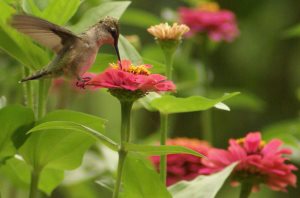
Hummingbirds will harvest nectar from flowers of all colors, although they seem to prefer red flowers. Thus, the color of most hummingbird feeders.
The bright red color on most hummingbirds will help with attracting hummers.
If you don't have a lot of color in your yard, (i.e. only green grass), then begin to decorate.
To attract visitors, hang up red clothes on the clothesline, get some fluorescent flagging tape and hang it in trees & shrubs.
They will come in for a closer look, even if it's not flowers.
We often have hummingbirds zoom down to our red truck, only to be disappointed that it's not the biggest red flower they ever saw. But once you lure them in with red items, they may stick around & find your feeder.
If you don't have plants that are flowering yet, put up some fake ones around the feeder.
Anything brightly colored, especially red and/or orange will help.
Red dye in the sugar solution is not necessary. Instead tie a red ribbon or stick red tap on the feeder itself to add color
If you have flowering plants, place hanging or potted plants of bright flowers near the feeder.
Attract Hummingbirds with a Bird Bath or Fountain
In addition to your feeders, you can also place a shallow bird bath or light mist fountain to attract hummingibirds to your backyard.
Where to Hang a Hummingbird Feeder
Place your new hummingbird feeder where hummers will find it easily.
Don't hang it under a tree or under the eave of your roof where they may not be able to spot it as they cruise by your neighborhood.
You many need to place your feeder out in a more open area at first to attract hummers.
Once they find your feeder, and are coming to it daily, then you can move it closer to where you can observe them better.
Don't worry, they'll find it even though you've moved it...
Do your kids stop looking for the cookie jar just because you've moved it to the other side of the kitchen? ;-)
Space, Perches, & Cover
Make sure your feeder has enough space around it for hummers to hover easily while feeding - not jammed pack up against the house or shrub, etc.
Hummingbirds prefer feeding locations where there are nearby perches (this is in addition to the perches that already may be on the feeder).
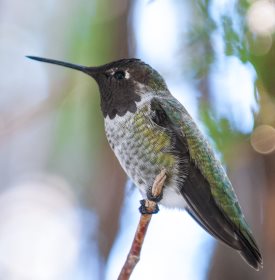
Perches in nearby bushes or trees provide a safe place to rest and watch over their food source (the feeder).
They also like to have a clear view of their surroundings and a clear get-away path to nearby cover if a predator should arrive.
But the advantage of feeders is that they will bring the birds to a specific location of your choice where you can observe them up close.
Up off the Ground
Place your feeders higher off the ground than lower.
Blem and Blem (1997) found that Rufous Hummingbirds occasionally foraged on flowers as low as 15 cm from the ground and as high as 10 m. The former was rare, however.
They hypothesized that avoidance of low flowers may reduce risk of predation.
Overall, hummingbirds usually preferred elevated sources over those near the ground.
Keep your feeder out of reach of cats, at least 6 ft off the ground. Cats kill millions of birds every year.
Shade
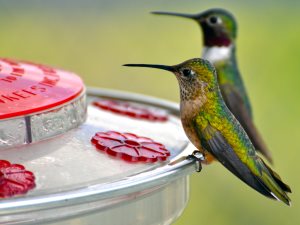
Which do your prefer?
Sitting under the heat of the sun, with a hot glass of tea on a hot summer day? Or sipping a glass of cool, iced tea under the shade? No- brainer.
Well hummers like their nectar not heated as well.
Try to place your feeder in a shady area, for at least the hottest part of the day, if nothing else.
Nectar heated by the sun spoils much faster than cooler, shaded nectar.
Additionally, cool locations will prevent the solution from heating & expanding, which sometimes causes the solution to drip out in those upside-down vacuum feeders.
If you just don't have a convenient shady area, you can improvise by creating your own shade for the feeder.
Take a plastic red plate, punch a hole in the middle and slide it over the support rod that the feeder is hanging from. Voila! Shade and more red color.
Also place your feeders at the right distance to avoid window collisions.
How to Clean a Hummingbird Feeder
You should clean your feeders at least every 3 days in hot weather and 6-7 days in cool weather.
Otherwise fermentation can occur and mold & bacteria will grow, which can be fatal to hummingbirds.
In addition, hummers won't like the taste of the nectar & stop coming to your feeders.
Clean the feeder with a mixture of hot water and a splash of vinegar. The vinegar will help remove any mold & bacteria.
You can also use lemon juice or dishwashing detergent - just make sure you rinse thoroughly to remove any residue.
You can also add some rock salt or uncooked rice in the rinse solution and then shake to help dislodge mold from hard to reach places.
Take a toothbrush or bottle brush to scrub any places that have intricate areas where mold or bacteria can accumulate.
Basically, clean your feeder enough so that you would feel comfortable drinking from it.
To recap cleaning your feeder:
- Empty reservoir and rinse in a mixture of hot water & vinegar
- Add rock salt or uncooked rice grains to the rinse & shake to dislodge mold (black scum)
- Empty feeder and rinse again thoroughly with hot water
- If mold or any other residue remains, scrub with a toothbrush or bottle brush
- Refill with nectar solution, hang feeder, and enjoy!
When to put up your hummingbird feeder? When to take down?
Look at hummingbird migration maps to get an idea of when hummers begin arriving in your location, which can be as early as February in the southern U.S. for ruby-throats.
Early travelers migrating north will take advantage of your feeder when flower production isn't as abundant.
During this time, hummingbirds often rely on sap produced by sapsucker (woodpecker) holes, insects, spiders, & perhaps even your feeder.
When should I take my feeder down?
Keeping a feeder up will not prevent a hummingbird from migrating.
Hummingbirds migrate because it is an innate, genetic instinct, not whether or not you keep your feeders out.
Factors such as weather, length of daylight, & fat accumulation stimulate migration.
There are some late, migrating stragglers that during cold days and adverse weather conditions will appreciate your feeder along its journey south.
As a general rule, wait 2 weeks after the last bird was seen before bringing it in for winter.
Rufous Hummingbirds have been reported to linger around in the northeast late into fall & early winter.
For the most part, hummingbirds are rarely dependent upon feeders to survive.
If you have a feeder & take it down, don't worry - they won't starve. They'll just find another food source (other feeders, flowers, and/or insects & spiders).
Hummingbird Feeder Pests
Insects love sweets too. In order to keep ants, bees, & other pests from visiting your feeder you will need to take some preventative measures.
Bees and Wasps - Bee Proof Hummingbird Feeder
Try to purchase a feeder that has wasp and bee guards (feeder example with bee guards).
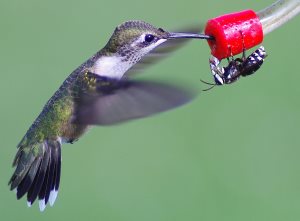
They are small criss-crossed screens that fit over the
feeding ports. They keep bees out, but allow long, hummingbird bills
in.
small criss-crossed screens that fit over the
feeding ports. They keep bees out, but allow long, hummingbird bills
in.
If you have a vacuum feeder that drips, the guards won't help as much because the bees will be able to lick the leaking liquid around the feeding ports.
If you are having a lot of trouble with bees, try switching to a saucer feeder that won't drip. Bees may still be attracted to the smell, but you won't have as many.
As another option, try moving your feeder. Bees and wasps have habitual daily flight routes they follow and you may be able to lose them by moving the feeder.
They may never find it in its new location, whereas the hummingbirds will.
If that doesn't work, take the feeder down for a day or two, until you stop seeing bees and wasps.
Hopefully, the bees will stop coming to your feeder location, change their route and seek out another nectar source.
And don't worry, you shouldn't lose your hummingbirds. They'll come back. They don't give up as easily as bees.
You may want to consider putting up a bee or yellow jacket trap in addition to trying the other options if they are still a nuisance.
It will help with reducing the volume of bees that are around your feeders, but may not completely eliminate them altogether.
Keeping Ants Out of Hummingbird Feeder
Ants can also be a problem.
To deter the ants, some suggest applying a coat of vasoline or cooking spray on the support arm above the feeder, which will create a barrier to the feeding ports, however this can be harmful to birds if they come in contact with any kind of oily substance, especially on their feathers.
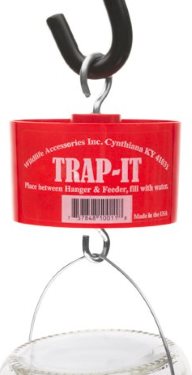
Some feeders also come with moats that you fill with water to prevent ants from crossing over to the nectar, but these must be kept full in order to work.
Read our tips on how
to keep ants out of your hummingbird feeders for
more information.
Other Birds
Orioles, house finches, woodpeckers & other sugar-loving birds will be attracted to your hummingbird feeder as well.
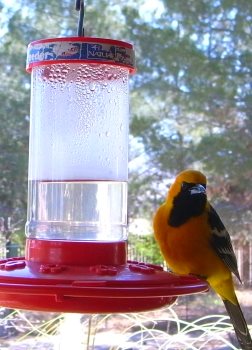
If you don't mind them sharing the feeder-time with the hummers, do nothing.
If you do mind, there are some things you can do to prevent them from "sharing".
If you purchase a feeder without perches, it will be more difficult for other birds to feed because they can't hover.
It's not a 100% deterrent, as some determined birds will acrobatically hang on anything they can to get a sip of sweetness.
But it will slow them down and may prevent others from landing who aren't so acrobatically inclined.
You can also put up fruit feeders for these birds.
Put out fruit such as halved apples or oranges, and/or small containers of grape jelly to attract orioles & others away from the hummer feeder.
Hummingbird Fights
Individual hummingbirds can become quite possessive over their feeders, dive-bombing on others that want to feed from their nectar source.
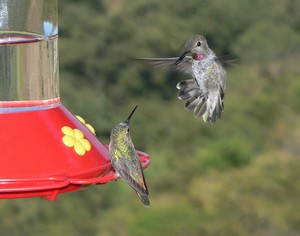
Place out several feeders if this becomes a problem for you. Place them where one bird can't guard both from any single overhead perch.
Blem and Blem (1997) found that birds partitioned themselves at different feeder heights in order to have free access without competition.
So try placing several feeders at different heights to keep the dominant one guarding the feeder above while others feed below.
Hummingbirds Feeding Out of Our Hands
Below is a fun video of rufous hummingbirds feeding out of several different people's hands after they spend some time watching them during their stay at the Saltery Lodge in Alaska:
So now it time to turn off the TV, get yourself a hummingbird feeder, and be entertained by the live action-adventure episodes right outside your back yard!
What feeder attracts the most hummingbirds?
Hummingbirds are attracted to brightly colored feeders that have some red, orange, or pink on them.
When I first put up a feeder in the spring, I add some red ribbons or flagging as an extra attractant until the hummingibrds start coming. The strands of red move in the wind and is more noticeable to passing hummingbirds than just the static red color on the feeder.
A feeder with multiple feeding ports and one that allows hummingbirds to perch as opposed to hovering while feeding is also more desirable.
Also be sure to have the correct ratio of sugar to water (1:4) because if it is too diluted, they likely will move on to find another feeder with sweeter nectar.
Do hummingbirds prefer glass or plastic feeders?
Hummingbirds don't have a preference for glass or plastic feeders, and as mentioned above, they are more attracted to the color and sweetness of the nectar inside the feeder.
However, there are some differences between glass and plastic feeders that you may want to consider when choosing a feeder
Glass feeders are generally more durable and easier to clean than plastic feeders.
They are less likely to crack or discolor over time, and they can be washed in the dishwasher. However, glass feeders are heavier than plastic feeders and may break if dropped or knocked over.
I personally prefer glass hummingbird feeders because they are easier to clean, they look nicer, and if BPA and other plastic chemicals can affect us, maybe they can affect hummingbirds too, so I rather not take the chance and just use glass feeders.
Hummingbird Feeders, Nectar Recipe, Ant Problems:
Favorite Window Hummingibird Window Feeder - Watch hummingbirds up close at your window!
Hummingbird Food Recipe - The correct ratio of sugar to water that hummingibirds prefer.
Don't Use Red Dye in Hummingbird Nectar - Red dye is not neccessary in hummingbird nectar.
Problems with Ants at Hummingbird Feeders - How to keep ants out of your feeder.
DIY Hummingbird Feeder - Make your own hummingbird feeder with simple household items.
Glass Hummingbird Feeders - Decorative blown glass feeders.
Hummingbird Gifts:
Hummingbird Gifts - Unique hummingbird gifts.
Hummingbird Fun Facts
Hummingbird Fun Facts - Learn interesting facts about hummingbirds.
Hummingbird Migration - When do hummingbirds migrate, how far do they fly, where do they go?
Hummingbird References - Cited reference articles.
Attracting Hummingbirds:
Attracting Hummingbirds - How to attract hummingbirds to your backyard.
Hummingbird Habitat - Create a hummingbird habitat by providing food, shelter, and water.
Hummingbird Garden - Plant a garden of vaious flowers and shrubs.
Hummingbird Flowers - Favorite flowering plants that hummingbirds love.
Hummingbird Species:
Ruby-throated Hummingbird - Fun facts about the Ruby-Throated Hummingbird.
Broad-tailed Hummingbird Fun facts about the Broad-tailed Hummingbird.
Related Birdwatching Pages
Bird Feeders Main Page - Best bird feeders of all types - hopper, platform, thistle, suet, peanut, more.
Oriole Feeder - Orioles like fruit, jelly, and nectar like hummingbirds.
Bird Feeder Pole - Best pole to install your feeder.
Why Won't Hummingbirds Come To My Feeder or Why Have They Disappeared?
We receive a lot of questions from people who put up a feeder for the first time and don't get any hummingbirds and/or have been putting up hummingbird feeders for years and all of a sudden the hummingbirds disappear or never show up.
There are some things you can do to attract hummingbirds to your feeder, as mentioned above, and then all you can do is wait.
Either habitat is suitable in your neighborhood to attract them or not.
As to why hummingbirds just suddenly disappear or come to your feeder in less numbers, well that's always hard to pinpoint. Please read below for possible explanations.
Janet Asked: Hi, My question is I don't understand it, but last year I had 6 Ruby throated hummers come to my garden and before that always 2.
This year I saw a hummer 1 day and I have not seen one all summer.
I put out 2 feeders to start with. I was wondering if something has disrupted their migration across Illinois?
Like the global warming or something else that is going on with the climate this summer. Thank you for any information.
Bliss Said: Has anything to your local neighborhood habitat, within 1-2 miles, changed between last year and this year?
For example, a new development or other construction that would have decreased nesting and/or food resources such as flowering plants?
It's hard to pinpoint exactly why
hummingbirds are not coming to your garden, but surrounding habitat
change could be a source even if you had several feeders up.
In regards to global warming, it would initially expand hummingbird migration
north, as food sources and habitat would increase.
If temperatures continued to rise, perhaps hummingbirds' tropical habitat would decrease because higher temperatures would affect rain cycles and vegetation growth.
And this in turn would affect hummingbird populations and numbers that migrate north.
However, when looking at recorded hummingbird migration observations, it looks like ruby-throated migration was abundant across the entire state of Illinois.
You therefore are experiencing a local, definitely not global or even statewide change.
Tammy-Jo Asked: I have been feeding hummers for years, this is the third year at my current home.
This season the birds were plenty and then all of a sudden they stopped coming to my feeder.
I have flowers that they love, but they seem to have disappeared all together.
My children have really developed their passion for these flying jewels and are so worried about them. What can we do!?
I know already the importance of cleaning the feeder and the general rules to help the birds stay happy and healthy but I need your further help. PLEASE!!
Similarly, Bill Asked: Our Hummers arrived on May 1st and have been very active until 3 days ago.
I've cleaned the feeders and changed the sugar-water three times and they have just stopped coming. Why? We enjoy them so much! -Bill
Also, Duke Asked: This time of May, my 2 feeders are constantly busy with many rufus', but a couple of weeks ago they disappeared except for just a couple once in awhile. Being concerned in Quillayute Valley, Forks Washington.
Thank you for any information on this perplexing dilemma as I have been putting up feeders for several years now, and the Rufus Hummingbird usually leaves about August.
And Jill Asked: Here in north central Texas, the black-chinned hummers came back on Easter weekend. Females and males were numerous.
Then two weeks ago, a house finch started feeding at my sugar water feeders and the hummers have disappeared.
Will they stay away or will they come back later?
We had a wet winter that caused abundant wildflower blooms this spring. Does that have something to do with the hummers leaving?
Bliss Said: It has been suggested that during the nesting season hummingbird visitor frequency may go down or completely stop.
Once the females lay eggs, they spend a lot more time incubating and staying close to the nest.
So some of the females may not be visiting your feeder anymore and getting nectar & insects elsewhere.
But after the chicks fledge (leave the nest), expect the number of hummers at your feeder to be double what it was before the "disappearance." Full explanation can be found here.
At the same time, the males will be busy defending their territories.
If there is a territory within close proximity to your feeder, one male could be driving away all the other hummers, defending the feeder as his. It's also possible the hummingbirds that were visiting your feeders are still migrating and have moved north.
This is just one explanation, but also look locally in regards to habitat change as mentioned above to Janet's question.
If so, try to attract hummingbirds with even more obvious displays of color.
Tie red ribbons on or near feeders, put up brilliant-colored hanging baskets of flowering plants, anything that will attract hummingbirds.
I'm assuming that you already know not to use pesticides on or near your flowering gardens.
For both Tammy-Jo and Bill, I wouldn't worry too much. You should see hummingbirds come and go in different numbers throughout the summer months.
And Jill, It's likely that many of those black-chins visiting your feeder during April were migrating through, using your feeder to fuel up before continuing on north.
Your local hummingbirds should now be there and yes, it is possible that if there are abundant sources of natural nectar, more so than usual, than you may see less hummingbirds, possibly none.
Otherwise, the house finch shouldn't keep the hummers away.
As flower blooms decrease, I would expect hummingbirds to return to your feeder and it still is possible they will return earlier.
Tammy-Jo's Reply: Hello birder-friend! It was so awesome to hear back from you so quickly!
Today I hung a new feeder with the resting ring for them to take a break from drinking, and also put a huge red bowl upside down and over the feeder to give it some shade,
I had never thought of the nesting and the babies keeping the parents away from the feeders!
I have never read that either! I feel so much better since getting your email.
The hummers "disappeared a few days BEFORE my husband did some weed-eating, so the habitat hasn't changed.
Hopefully they will return soon, I plan to add some flowering bushes around the feeder also. I will "talk to you later "with an update!, Tammy-Jo.
Tammy-Jo Update: Hello Dear Birder! The hummers are back just as you predicted! Thanks so much! -Tammy-Jo. (Hummingbirds disappeared May 26, returned June 7).
Vel Asked: I have just discovered hummingbirds. I put out my feeder in the beginning of April cause I couldn't wait.
They finally came at almost the end of April. There were a lot of them, seemed like every 20 minutes.
Then within a few weeks time they were gone. I keep putting out fresh nectar, but not even one bird comes!
What did I do wrong and how can I get them back. Now it is the end of May. Can you help? Have you ever heard of this happening before?
Bliss Said: I'm guessing most of the birds you were seeing at your feeders in April were migrants and then once migration was done, they've disappeared.
I don't know what kind of habitat is around your area, but it's possible that it's not suitable for breeding and nesting for hummingbirds and so they've moved on and migrated north.
Do you live in a city, suburb or rural area? Are there plenty of trees, shrubs, flowering plants in your nearby area? Let us know. Maybe we can come up with some other reasons or a way to attract hummingbirds back to your feeders.
Raccoons, Bears and other Mischievous Lovers of Sweet Nectar
Have you ever gone to bed with a full bottle of nectar hanging outside for your morning hummingbirds only to find it completely empty before dawn?! Read below...
Momma Bear and Cubs Eating Hummingbird Feeder Nectar
Shannon asked: Good morning! I am having an issue with my hummingbird feeders.
I've noticed now, for 4 days (when I started putting them out), that the sugar water disappears overnight.
I've watched them all day, making sure the levels are the same (I have two), and then I go to bed.
I wake up to empty feeders, not even seemingly touched or moved. I believe it to be raccoons.
Would it be bad to bring in the feeders at night and put them out in the morning? Or do you have any other suggestions? I appreciate it.
Bliss answered: It would be fine to bring them in if you want. Otherwise you will need to outsmart the raccoons which is no easy task.
Some move their feeders away from any trees and mount the feeder on a pole with a baffle to keep the raccoons off.
Anything you can do to keep the raccoons from reaching the feeder from below or above will help if you want to keep it outside.
I've even heard of people buying a product that contains dried coyote urine (normally used to repel deer, elk, armadillos, javelina, wild boar, feral pigs, etc.) and sprinkling it around the area where they don't want raccoons.
Some said they just have an adult male pee around the area at night. Your call! :-)
Victoria, from our Facebook page, also notes this possibility during hot weather:
I wanted to mention: during extremely hot summer weather, our hummingbirds only come out at late dusk (~8-9:30p) and dawn (~4:30-6a), so it seems like they're being drained at night by magic.
We only notice them zooming around if we're up late or early.
Shannon replied: Thank you for responding. I think we will move them to a new location, where the raccoons won't reach them. Right now, they are on a fence line, so it's real easy for them. lol
Jasper Said: I made my own hummingbird nectar today and gonna try it out. I got 3 feeders for mothers day. I like the simple things in life. I enjoy watching the hummers and so do my grandsons.
We are nature seekers and they get so excited about the little things in life. They just need to know that life can be simple, but fun too.
Bliss Said: Hope you get plenty of visitors with your 3 hummingbird feeders, Jasper. I love taking time out in the day to just sit and watch the hummers and other birds at our backyard feeders. I too enjoy simplicity.
Heated Hummingbird Feeder
Terri Asked: How can I create a heated feeder?
We have many hummers who stay year round in Washington state.
I try to take my feeder in at night and bring back in the morning, but I often forget. Wish someone made a heated one.
Well we had some suggestions, but Terri came up with an ingenious, yet simple and cheap way to keep her nectar from freezing shown in the video below:
How To Keep Hummingbird Nectar From Freezing
Should Hummingbird Feeders Be In The Sun Or Shade?
If you can, place your hummingbird feeders in the shade to keep the sugar solution from getting warm which can promote fungal and/or bacterial growth.
But, even in the shade, the nectar should be replaced every few days at a minimum.
If it's warmer - 90 degrees or more - replace the solution at least every 2 days.
If you have no trees for shade or an overhang from your house, you can attach something above the feeder to create shade such as in the video below:
Hummingbird feeder photo (top) courtesy of Larry Lamsa
Images of hummingbird feeder with hornet, and two hummingbirds on feeder courtesy of Jeffrey W, Cbede, and Brady Smith from the U.S. Forest Service, Coconino National Forest, respectively.
|
Our Favorite Bird Watching Binoculars, Squirrel-Proof Feeder & Hummingbird Feeder Read Our Reviews: |
||
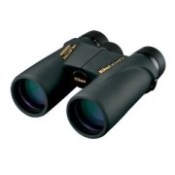
Nikon Monarch M5
Best mid-priced bird watching binoculars. Waterproof, shockproof, multi-coated ED-Glass. |
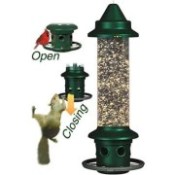
|
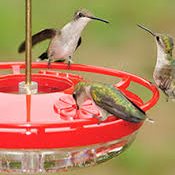
Best Hummingbird Feeder
Drip-Free, Ant-moat, Durable, Easy to Fill and Clean. |
| Click Images or Links To View More Info | ||
Subscribe to Our FREE Newsletter: The Birder Alert!
